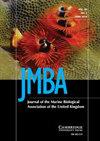在冰岛西北部以叶绿藻为主的潮间带,外来入侵的巨蟹(Cancer irroratus)和本地巨蟹(Carcinus maenas)的范围向极地扩展
IF 1.1
4区 生物学
Q3 MARINE & FRESHWATER BIOLOGY
Journal of the Marine Biological Association of the United Kingdom
Pub Date : 2024-02-12
DOI:10.1017/s0025315423000905
引用次数: 0
摘要
冰岛西北部布雷达夫约瑟尔(Breiðafjörður)遮蔽海岸的岩石潮间带主要生长着单一的冠层褐藻(Ascophyllum nodosum),它们为移动生物提供了栖息地,并长期受到轮伐。我们调查了这一地区鲜有研究的移动腕足蟹的组合组成,以追踪本地物种应对气候变化的分布变化,以及潮间带主要被潮下带入侵非本地物种占据的程度。研究还探讨了海藻捕捞可能产生的交互影响。将 Breiðafjörður 与冰岛西南部 Faxaflói 的两个参考地点进行了比较。研究结果显示,该地区的原生欧洲青蟹 Carcinus maenas 明显向极地扩展,尤其是在中层海岸取代了原生蜘蛛蟹 Hyas araneus。入侵的非本地大西洋岩蟹(Cancer irroratus)在潮间带的占有率微乎其微,表明其对潮间带蟹类的组合、组成和丰度影响有限。目前在 Breiðafjörður 捕捞 A. nodosum 的制度并不影响潮间带岩石区腕足动物蟹群的组成和数量。H.araneus可能受到了C. irroratus在潮下和潮间带的挤压。总之,我们对潮间带岩石区气候变化、入侵物种和人类活动之间的潜在相互作用提供了深入的见解。本文章由计算机程序翻译,如有差异,请以英文原文为准。
Range extension of invasive Cancer irroratus and native Carcinus maenas polewards in the Ascophyllum-dominated intertidal zone in north-west Iceland
The rocky intertidal zone of sheltered shores in Breiðafjörður, north-west Iceland is dominated by monospecific stands of canopy-forming brown algae Ascophyllum nodosum , which provide habitat for mobile organisms and has been subjected to long-standing rotational harvesting. We investigated the assemblage composition of little-studied mobile brachyuran crabs in this area, to track distributional shifts in a native species responding to climate change and extent of occupancy of the intertidal by a primarily subtidal invasive non-native species. Potential interactive effects of seaweed harvesting were explored. Breiðafjörður was compared with two reference sites in Faxaflói, south-west Iceland. The study revealed clear poleward expansion of the native European green crab Carcinus maenas in the region, displacing the native spider crab Hyas araneus particularly at mid-shore levels. The invasive non-native Atlantic rock crab Cancer irroratus had negligible occupancy in the intertidal zone, indicating limited effects on the intertidal crab assemblage, composition, and abundance. The current harvesting regime of A. nodosum in Breiðafjörður did not affect the composition and abundance of the brachyuran crab assemblage in the rocky intertidal zone. H. araneus is likely being squeezed by displacement subtidally by C. irroratus , and intertidally by C. maenas . Overall, we provide insights into the potential interactions between climate change, invasive species, and human activities in the rocky intertidal zone.
求助全文
通过发布文献求助,成功后即可免费获取论文全文。
去求助
来源期刊
CiteScore
2.30
自引率
8.30%
发文量
68
审稿时长
3-8 weeks
期刊介绍:
JMBA is an international journal, publishing original research on all aspects of marine biology. It includes pioneering work taking place today on major issues concerning marine organisms and their environment. Subjects covered include: ecological surveys and population studies of marine communities; physiology and experimental biology; taxonomy, morphology and life history of marine animals and plants; and chemical and physical oceanographic work. Included with 2010 online subscriptions: Marine Biodiversity Records.

 求助内容:
求助内容: 应助结果提醒方式:
应助结果提醒方式:


